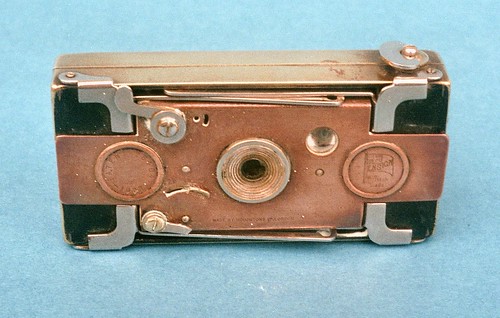Ensignette

|
| version with f/11 meniscus lens behind shutter and aperture, folded |

|
The Ensignette was one of the very characteristic camera types of Houghton's Ltd., London. This strut folding rollfilm camera of Houghton's "Ensign - British made" brand was an ingenious construction, a real vest pocket item when folded. One of the round framed imprintings on its front plate says that it was based on patent 28464 of the year 1907. The Swedish engineer Magnus Neill had designed this first British all-metal camera of which ten-thousands were made. The camera was launched before Christmas 1909. It was ordered by distributors all over the world, for example by G. Gennert.
The camera was designed like a luxuriuos cigarette metal etui, with parts made of different kinds of brass and other metals, except some interior parts and the bellows which was made of very thin leather. Some metal parts were plated. The front standard had to be pulled into working postition. It was like a little box pulled out of a greater box, the smaller containing lens/shutter/aperture unit, controls and even a brilliant viewfinder. Three different round aperture masks were selectable, and the shutter release was switchable from instant to time mode. Kodak's film type No. 128 fitted this camera.
The standard lens was an f/11 achromatic meniscus lens, variants of the camera were equipped with an "Ensign" Anastigmat f/5.6, a Cooke Anastigmat f/5.6, or a Goerz Syntor f/6.8. The lenses were not focusable.
The Ensignette was followed by the No. 2 Ensignette in 1912 and Houghton-Butcher's Cupid aluminium camera in 1920.
links
- Ensignette at www.ensign.demon.co.uk [1]